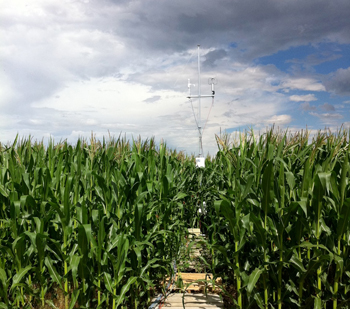A .gov website belongs to an official government organization in the United States.
A lock () or https:// means you've safely connected to the .gov website. Share sensitive information only on official, secure websites.
9 August 2012

Changes in the composition of transportation fuels are showing up in the atmosphere.
Ethanol, now used commonly in U.S. transportation fuels, is turning up in urban air at more than six times the levels measured a decade ago, according to a new study by a team of NOAA researchers and colleagues. The research team found no discernible impact of increased ethanol on air quality.
Ethanol produced from corn and other crops has been promoted as a renewable transportation fuel. Gasoline sold today in the United States contains, on average, nearly 10 percent ethanol, compared with about 1.3 percent in 2000. Ethanol is now the most prevalent compound in the gasoline sold in the United States (gasoline and diesel fuel are complex mixtures of many chemicals, mostly refined from petroleum).
"Increasing the ethanol in fuels is leaving a clear signature in the atmosphere," said Joost de Gouw, an atmospheric chemist with CIRES at the University of Colorado Boulder, and lead author of the new paper "Increasing atmospheric burden of ethanol in the United States" published in Geophysical Research Letters earlier this month. CIRES is a collaboration between the University of Colorado Boulder and NOAA.
De Gouw and his colleagues at NOAA made measurements of urban air during four air quality research campaigns between 2002 and 2010. While many aspects of urban air composition were similar between the four studies, ethanol stuck out: It was six times higher in 2010, reflecting the increased use of fuel ethanol. Ethanol in the atmosphere is not easy to measure, and this study is the first to track its trends over time.
Ethanol is not considered an air toxin, but the Environmental Protection Agency does consider one of its byproducts, acetaldehyde, a hazardous air pollutant. And acetaldehyde can react in the atmosphere to form ground-level ozone, which is also regulated because of its health effects.
Previous research had suggested that the increased use of ethanol in fuel could increase acetaldehyde and ozone pollution. By contrast, de Gouw and colleagues found that acetaldehyde levels dropped in Los Angeles between 2002 and 2010, despite steady increases in ethanol use. Acetaldehyde can be formed from many different compounds in the atmosphere, de Gouw said, "and most of those compounds have gone down in the atmosphere over the last decade, because of cleaner vehicles."
"This was a surprise," de Gouw said. "When we looked at acetaldehyde, we expected to see an increase because ethanol had become ubiquitous. We found no evidence for this detrimental effect on air quality."
de Gouw, J. A., J. B. Gilman, A. Borbon, C. Warneke, W. C. Kuster, P. D. Goldan, J. S. Holloway, J. Peischl, T. B. Ryerson, D. D. Parrish, D. R. Gentner, A. H. Goldstein, and R. A. Harley, Increasing atmospheric burden of ethanol in the United States, Geophysical Research Letters, doi:10.1029/2012GL052109, 2012.
The use of ethanol as a transportation fuel in the U.S. increased significantly from 2000–2009, and in 2010 nearly all gasoline contained 10% ethanol. In accordance with this increased use, atmospheric measurements of volatile organic compounds in Los Angeles in 2010 were significantly enriched in ethanol compared to measurements in urban outflow in the Northeast U.S. in 2002 and 2004. Mixing ratios of acetaldehyde, an atmospheric oxidation product of ethanol, decreased between 2002 and 2010 in Los Angeles. Previous work has suggested that large-scale use of ethanol may have detrimental effects on air quality. While we see no evidence for this in the U.S., our study indicates that ethanol has become a ubiquitous compound in urban air and that better measurements are required to monitor its increase and effects.